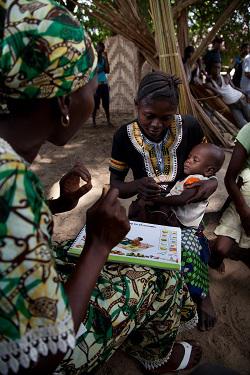
In Sierra Leone, nearly one third of children under the age of 5 are chronically malnourished. One community is using mothers’ support groups to address child malnutrition.
ROGBONKO, Sierra Leone, 13 April 2016 – It’s eight o’clock on a Saturday morning, and the Rogbonko village centre fills with cheerful song and laughter as women gather around a simple picture book. This is the weekly meeting of the Rogbonko mothers’ support group, where pregnant women, breastfeeding mothers, and mothers with young children from the community come together to learn about nutrition.
“We are here to talk about how we should take care of our children in the best way so that the children can grow up well,” says Rugiatu Kamara, chairwoman of the group.
The danger of child malnutrition
Sierra Leone has one of the highest rates of child mortality in the world with more than 120 children per thousand dying before they reach their fifth birthdays. Poverty and a lack of food can play a part, but most of these deaths are preventable with simple interventions such as proper nutrition. Worldwide, malnutrition is an underlying factor in close to half of under-five deaths, and in Sierra Leone, nearly one third of children under the age of 5 are chronically malnourished.
“The main reason for malnutrition in the community is because some people do not know what kind of food they should give to their children - when and how, and the frequency with which they should be fed,” said Fatou Tarawalie, a nutritionist with the NGO World Hope International (WHI). With UNICEF’ support, WHI is managing the mothers’ support group nutrition programme in the Bombali District.
Colourful solutions
One of the greatest challenges in eliminating malnutrition is disseminating life-saving knowledge in a simple way that can be used in communities throughout Sierra Leone, which has a literacy rate of just 48 per cent for the over-15 population.
To help solve this problem, UNICEF developed an illustrated book, which Rugiatu now uses to lead discussions on nutrition and feeding practices. The picture-filled pages contain information on maternal, infant and child feeding, including what pregnant women, babies and young children should be eating, how often, and in what quantities to ensure optimal health.
After a general discussion with the entire group, Rugiatu makes her way around the circle to check the nutritional status of children aged 6 months to 5 years old. For this assessment, she uses the colour-coded Mid-Upper Arm Circumference (MUAC) tape, which helps to identify if children are malnourished and the level of severity. Green indicates healthy, yellow suggests moderate acute malnutrition (MAM), and red signals severe acute malnutrition (SAM) – a condition that can be deadly if left untreated.
“When I use the MUAC tape and the child falls under the yellow, I will tell the mother that her child is at risk of falling sick and that she should pay attention to what she is feeding the child,” said Rugiatu. “If it is red, it indicates that the child is sick and I will tell the mother to take her child to the hospital.”
On this particular Saturday, all the children have green MUAC readings, except 15-month-old Morlay, whose MUAC measurement is yellow.
Rugiatu explains to Morlay’s mother, Kayima Kaloko, what the yellow MUAC reading means, and proceeds to counsel her on how she should be feeding her child using the nutrition picture pages for children aged 12 to 24 months. The illustrations indicate that she should be complementing breastfeeding with a good mix of fruits, vegetables and cereals. The book also explains how frequently she should be feeding Morlay, and the importance of maintaining good hygiene practices when preparing the food and during feeding.
Kayima promises to follow the advice. “The first thing I will do when I get home is find the right food for my son to eat,” she said.
After finishing with Kayima, Rugiatu turns to the pregnant women in the circle. Using the picture cards depicting optimal feeding during pregnancy and breastfeeding, they discuss the importance of eating properly for the health of both baby and mother.
A bright future
“I am happy because at least now people in the community know what to do,” said Fatou, the WHI nutritionist. “Normally, the rate of malnutrition is high, but with the help of the mothers’ support groups, it is now decreasing.”
Fatou explained how before, when their children were sick, many women would just leave them at home. Now they are referred to the Peripheral Health Unit where there is an Outpatient Therapeutic Program (OTP) and they can get life-saving treatment for severe acute malnutrition. Every Friday, severely acutely malnourished children enrolled at the OTP centres are given UNICEF-supplied Ready-to-Use Therapeutic Food (RUTF). With successful treatment they can be healthy again in 6-8 weeks’ time.
And the mothers’ support groups are helping to improve health in other ways. Following the devastating Ebola outbreak in Sierra Leone, many people were fearful of approaching health clinics. Through their weekly meetings and counselling sessions, mothers’ support groups are rebuilding confidence and encouraging the use of government health facilities.
These low-tech interventions – mothers’ clubs, picture books and colour-coded tape – are leading the battle in these communities against childhood killers like malaria, pneumonia, measles and diarrhoea. By sharing the best advice and catching malnutrition in its early stages, communities have the tools they need to reduce Sierra Leone’s tragic rates of child mortality.
Source: UNICEF
 FR
FR EN
EN AR
AR








